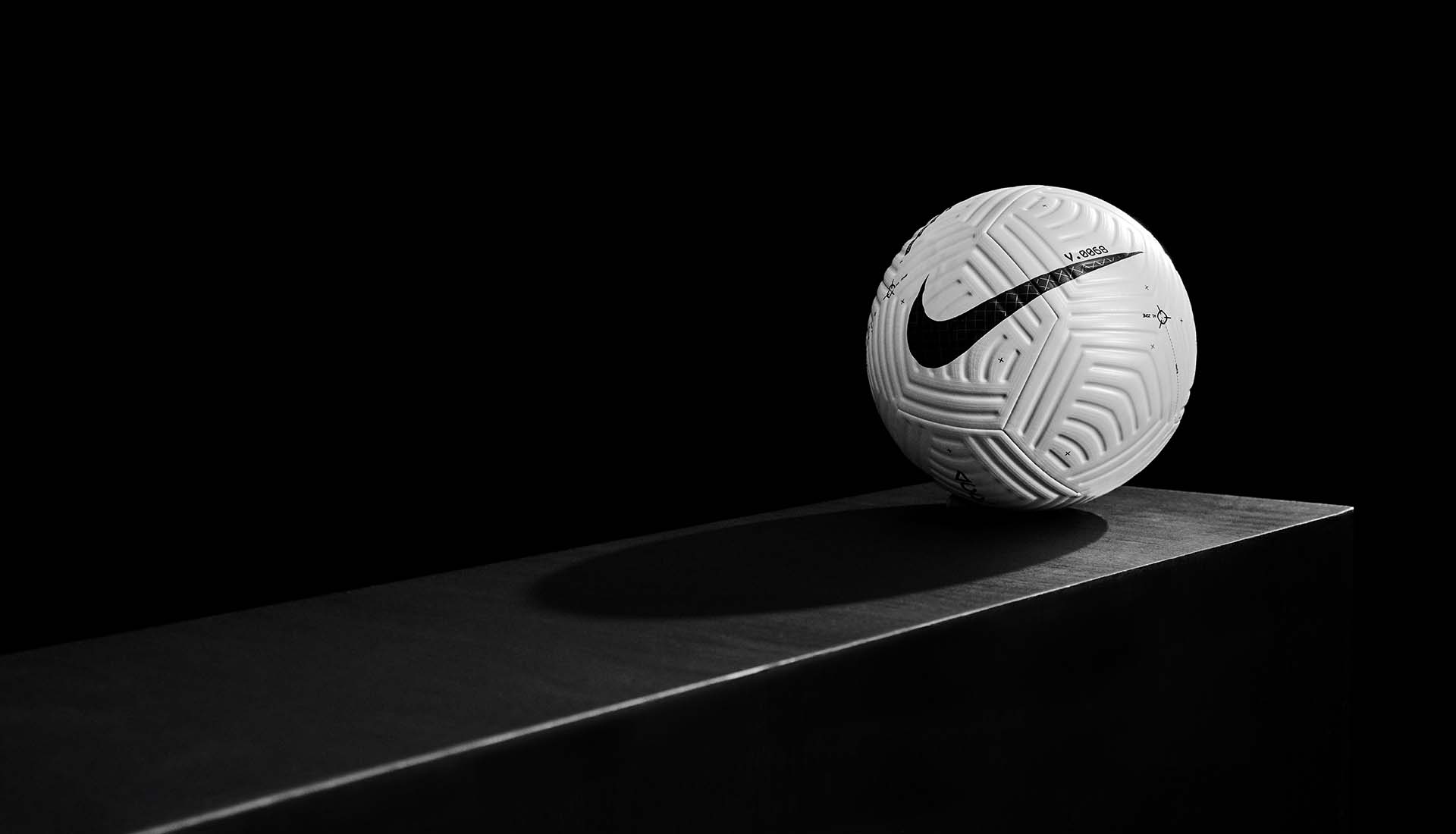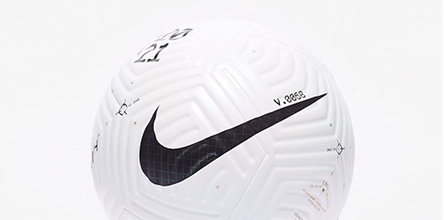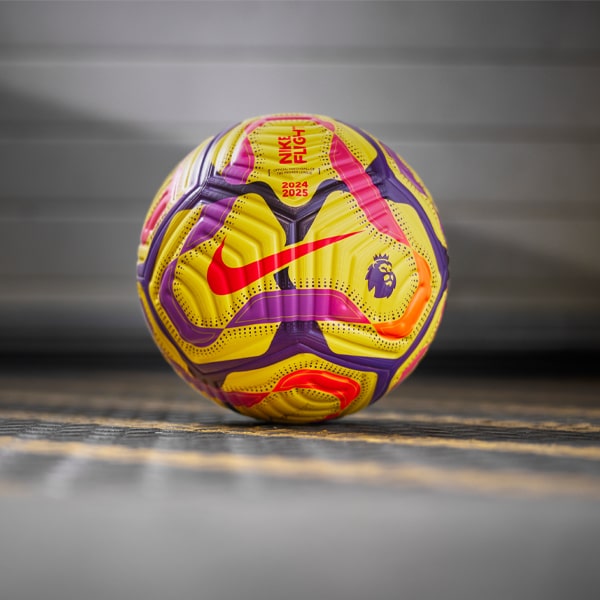As a brand always expressing a desire to innovate, change and inspire the game, the latest product drop from the world of Nike Football has been the revolutionary 'Flight Ball'. A piece of engineered footballing history, it is the subject of our first instalment of 'Dropology'. Hearing from Nike's Senior Director of Global Equipment, Kieran Ronan, we get a first hand insight at the story behind the performance product.
Looking for aerodynamic accuracy, you can be excused for wondering what goes into eight years of product design. Exploring the back story and examining the details to which Nike go to break waves in performance innovation, this first dive into the deeper details highlights the desire for Nike to push forward, the quest for sheer excellence and the way to do it with style running throughout.
Of all the the things that you've done at Nike, you must have seen and experienced such an array of groundbreaking products. Where does this sit in in correlation to everything else you have done?
It's a great, great question. I mean, from my standpoint, the journey that this team has been on, we've got members on the team who are working in this equipment business for 20 years. I actually personally sold the original Geo Merlin ball back and we sold it in ’99, so it was good to go for the 2000 season. So hearing back then, I remember, coming from Ireland... When you went out to talk about being the roundest ball ever, what did that actually mean? And here I am 21 years later, standing, talking to you in the lab and having such a phenomenal experience over the time since I moved to the US to really get in behind the scenes and see what goes into this. For me and the team to have a brand campaign on the football just just talks volumes of where we see and the value of the sport globally. I'm hoping maybe to answer your question a different way...maybe in two months time that it'll hearken to some of the success that we've had over time and on other products. That would be phenomenal. But it's certainly up there on a personal level. The work that's gone into it, an eight year journey by the team to get to this point just shows that the level of passion and dedication that we have to any product that we want to bring to market.
You mentioned the innovation lab briefly, that shows the intent of Nike - it appears more like it's like rocket science that you're moving into as opposed to simply just designing a football. Can you tell us a little bit about the lab and the statement and investment in science puts out to the world from Nike?
It's very interesting when we bring, whether it's players themselves, FIFA, CONMEBOL, the Premier League, anybody who comes in here and sees this, suddenly becomes a five year old all over again. It's just amazing - the level of the science that goes into this. In the lab is all the test equipment that we need to work with the likes of FIFA. The ball kicking machine that we put the balls through, the durability test, it goes through thousands of cycles. Then there's the robot itself. It's a very well-made point in terms of how the technology has advanced over the years from slow motion video to the tracking system that we've brought in. It allows us to make leaps and bounds when you actually go back and look at the 20 history of the Premier League balls. Originally we had stitched balls, and then it moved through the various degrees of panels down to the 12th panel fuse, then to four panel, and here we are now, taking leveraging areas from the golf industry with the dimples on a golf ball. Even the cycling industry where you have dimples on the deep dish rims to cut through the air, it just it just keeps advancing. The thing I say is, we have to be keeping pace with and faster than the game itself. We just look at how the game has evolved even over the last five years, the fitness levels of the players as one example. Recovery is a huge, huge conversation that's going on now. Wellness, nutrition, things that just weren't even talked about 10 years ago. So that's just the amount of extra stimulus that comes into making sure we're front and foremost and staying in pace with and continuing to push technology and innovation to a new place.
You know, picking up the ball...when you see people walk into lab, they look at it and immediately there's almost this hugging of the ball situation. And it's universal. It's across the globe."
You said everyone that goes in that lab becomes like a five year old... The connection we all have with certain football’s is crazy. From the Nike Scorpion Balls, the T90 Ball, the clean all white ball with a swoosh from the Brazil commercial... Those balls, when you saw one at school made the person carrying it become an instant God for a minute. Did you see the introduction of the Flight as a landmark moment for the next generation like those that have gone before?
If I could replay your words back to you, you've nearly answered the question for me. You know, picking up the ball...when you see people walk into lab, they look at it and immediately there's almost this hugging of the ball situation. And it's universal. It's across the globe. You’re spot on in terms of younger players coming up. There's a degree of skepticism in sports. Sports professionals are, in a lot of cases, very, very superstitious. If you look at tennis players, you know, take Rafa Nadal, one of our sponsored athletes and the routine that he goes through. Footballers are no different in a lot of cases, and it's taking them on that journey with us and listening to them and going back and saying, “this is what we heard, try this out”, and it just becomes this whole process. When we brought this out and go through the testing and we started working with some of the under twenty three teams in the league, the eyes open. I was asked the question earlier on about how do you how does this compare with other launches in footwear or in apparel? In a lot of cases it's met with expletives. There's just sheer joy and the younger the player, the quicker they are to adopt almost because it's different. It's not what it used to be. It's not what my dad played with in some cases. And we hear that in footwear as well. So it's just it's amazing and your comment was so well made about whoever had it was almost like a god for a second. Our hope and wish is that this will have the same effect as we go forward.
Every time a new ball comes out, you hear about fine margins in football, but 30 percent than its predecessor is is a massive percentage. With the science that goes into something like this, you’d think it was about shaving small margins - not to sound sceptical but how can this ball be so much better than its predecessor?
In essence, when you get this ball in hand and see the deboss on the surface... if you track the period of time that we've been involved in this, as I said, that you'll see it called out here over the swoosh, that the 68 iteration... is that we've played with the shape, the depth, everything associated with the Aerowsculpt grooves. So it is it has been proven and tested here in the lab that it falls within the parameters that we set out to try and achieve. The one thing that really that no one of us can control today is the valve. When you see the top players taking an indirect free kick outside the box or even on a penalty, they're looking for the valve and where that valve will be positioned so that hey have additional control over the spin. We will continuously strive to to stay on the forefront of what that is but we're confident with the amount of testing and the work we've done with players that it stands up to the demands of the game and it gives us what players are looking for - consistency of flight on field and also from a keeper standpoint.
When it comes to things like the knuckleball style free kick. How do you consider that method when you're designing a ball that is based around the truest flight? You obviously don’t want to eliminate that technique or enhance it. Do you have to find a balance?
It's actually a very fair question. It's somewhere in between. Numbers don’t lie. In the finance world, everyone will tell you that. We’ve got the degree of the parameters that we're working with but it’s all about the essence. You're still looking for the essence of the game. You've also got know factors on what wind conditions are on a given day, what the humidity is, whether you're at altitude, the pressure that's put on a ball, all of those are additional factors that just add that degree that means it's going to be very, very difficult to say that you know the absolute nth degree of consistency. So it's the margins of where we're trying to improve and drive things forward over time which is rooted and grounded in science to give us that opportunity to be able to come and make these statements.
With the ball, it's almost like far more black and white whether it’s success that maybe a pair of boots given there’s so much player preference with boots. Does that mean you have to be more intricate in the design? You have to create something that works for everyone almost...
It’s true. It's not that you're suddenly working in isolation and then announcing it or bringing it to market. It has been this journey that you're validating. You're doing the testing. You're working with all the levels so you’re getting to a place where there's a strong level of confidence that the players have with us on this journey. The confidence that we have as a team and that we've looked at every single possible thing that we could do. If we just take, for example, four years ago, we didn't have the robot. The continuous improvement that we're bringing the engineers in the lab and the scientists that are are looking to other industries, pushing ourselves forward, not resting on our laurels and trying to trying to go always and chase what the next level of performance excellence is, in essence, it’s all about enhancing the sport of football.
You’ve mentioned iterations and the marks on the ball that signify the work that's gone into it. How do you actually know when you've reached the optimum sweet spot after so many iterations?
There's a timing component there which is where you're trying to get to. The players buy in. You've got the leagues buy in, you've got that people are comfortable with what we're proposing and what we're suggesting and what the benefits actually are. Then there comes a point in time when you've just got to cut and run. So 20/21 season coming up... We hit what we set out to do, we had the sign off from everybody..but it doesn't stop. We're already working on the next one. So it is just like we’ve had over the years with boots and similarly with apparel - the advances, the technology, everything keeps moving forward and we're trying to stay in front of that pace at all times.
What's the main feedback that you're looking for from both outfield players and goalkeepers when you go through the process of those iterations?
Good feedback is that the ball does what they wanted to do. From a keeper standpoint as they're tracking the ball through the air, that they had a sense of comfort that based on speed spin their own proprioception, their own experience, their expertise in what they do and the position that they play, that if they're going to take that lunge, that ball is going to be where they're hoping that they're going to be able to reach it. Similarly with the players in other positions, they want to know when they strike that ball, whether playing a long ball across the field or whether it’s diagonal cut through to another player, or a shot on goal that what's going on in here transfers to boot and ultimately it goes through the football itself.
An engineering question... Over the course of eight years, there must be so much more technology that comes to fruition that can help you while you're making something. Can that be a challenge in itself? Just as you think you’ve hit the final iteration, new technology comes out that means the product could be even better...?
You definitely try not to let it stunt progress. It largely comes down to timing of where new technology can be applied and fit in. The robot we have, when we brought that in, the tracking system that ultimately started out in golf about eleven or twelve years ago, that transferred into baseball and we now have we now used it in football as well. So it's about looking to other industries. The Aerowsculpt technology itself. You could say it has been inspired by the dimples on a golf ball or other things that are used out there. We're constantly looking. That's what the scientists and engineers are doing in the lab. Constantly looking at at how far out we are from new technology, what's feasible today, can our manufacturing base keep up with it - all those questions are constantly being asked in order to keep improving.
And on the aesthetic, obviously, that plays such a big part for the audience when they first see something like this. Can you talk us back why the stripped back and minimalist approach? It looks beautiful...
The whole intent of this particular colourway in this instance is essentially comes around legacy. Going back to that nineteen ninety nine European Cup final where we had the white ball with the obsidian and red outline on the swoosh. This is giving us an opportunity to talk about the ball and the innovation. It is a super clean colourway. IT’s very iconic with a paralysed white finish and the swoosh itself. Going through the details that are called out, the 68 above the swoosh - it allows us to pause for a moment in time to talk about the innovation and talk about the technology and what we're trying to do. You will see in the next couple of weeks when the league balls start to appear, how then would we apply the graphics and support of the innovation and take us on the journey as we go forward. Keeping front and centre the visual flicker that we're looking for, the visual that the colour acuity to allow players to be able to see and watch and track the flight of the ball.
That blank canvas also opens up possibilities in terms of collaborations and special editions. Are there any sort of plans in mind with this ball?
I’m getting the sign to cut here on that question [laughs]. Stay with us on that. We’ve been on a journey and you saw what we did last year by reissuing four of the balls from the last 20 years of the Premier League... This for us today is really ground in the innovation and trying to get that story out that where we're here, we're part of the game or passionate about that and have a love of everything that we do and certainly going forward, we will continue to push the bounds of where we can both in colour and so on.
Obviously some footballs become famous because of the number of goals scored with them and those kind of milestones that are attached to them. Do you aim for such targets like that or for Nike, is it simple about creating the fairest possible product?
In the halls of the lab we have these stats from over the years and it’s really interesting. Within a hundred or so goals, the seasons have largely been the same for the last twenty years. It’s about a thousand goals. The game is getting faster. The level of speed and the pace of play just continues to evolve. To your point on the fairness, it’s about giving every player the same opportunity to have that consistent feel, flight and touch and hopefully control. We’ll see where it goes. I’d love to have this conversation with you in 12 months time when the league hopefully finishes on time to see how many goals have been scored in that season. We’re hopefully that it will enhance the speed and excitement of the game.
Pick up the Nike Flight Ball at prodirectsoccer.com














